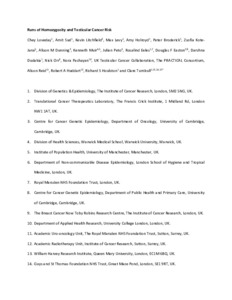Runs of homozygosity and testicular cancer risk
C. Loveday; A. Sud K. Litchfield; M. Levy; A. Holroyd; P. Broderick; Z. Kote‐Jarai; A. M. Dunning; K. Muir; J. Peto; R. Eeles; D. F. Easton; D. Dudakia; N. Orr; N. Pashayan; UK Testicular Cancer Collaboration; PRACTICAL Consortium; A. Reid; R. A. Huddart; R. S. Houlston; C. Turnbull
https://urn.fi/URN:NBN:fi-fe2021042825076
Tiivistelmä
Background Testicular germ cell tumour (TGCT) is highly heritable but > 50% of the genetic risk remains unexplained. Epidemiological observation of greater relative risk to brothers of men with TGCT compared to sons has long alluded to recessively acting TGCT genetic susceptibility factors, but to date none have been reported. Runs of homozygosity (RoH) are a signature indicating underlying recessively acting alleles and have been associated with increased risk of other cancer types.
Objective To examine whether RoH are associated with TGCT risk.
Methods We performed a genome-wide RoH analysis using GWAS data from 3206 TGCT cases and 7422 controls uniformly genotyped using the OncoArray platform.
Results Global measures of homozygosity were not significantly different between cases and controls, and the frequency of individual consensus RoH was not significantly different between cases and controls, after correction for multiple testing. RoH at three regions, 11p13-11p14.3, 5q14.1-5q22.3 and 13q14.11-13q.14.13, were, however, nominally statistically significant at p < 0.01. Intriguingly, RoH200 at 11p13-11p14.3 encompasses Wilms tumour 1 (WT1), a recognized cancer susceptibility gene with roles in sex determination and developmental transcriptional regulation, processes repeatedly implicated in TGCT aetiology.
Discussion and conclusion Overall, our data do not support a major role in the risk of TGCT for recessively acting alleles acting through homozygosity, as measured by RoH in outbred populations of cases and controls.
Kokoelmat
- Rinnakkaistallenteet [27094]
